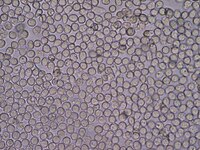
Photo from wikipedia
Objective Urinary tract infection (UTI) is a common cause of morbidity and hospitalisation in the population worldwide. Upper UTI is indolent and causes subclinical acute kidney injury (AKI) resulting in… Click to show full abstract
Objective Urinary tract infection (UTI) is a common cause of morbidity and hospitalisation in the population worldwide. Upper UTI is indolent and causes subclinical acute kidney injury (AKI) resulting in preventable cause of scarring of renal parenchyma. We explored urinary and serum levels of kidney injury molecule-1 (KIM-1), haematological parameters and quantitative urine microscopy parameters to predict kidney injury. Methods Neutrophil–lymphocyte ratio (NLR) is obtained by dividing absolute neutrophil count with absolute lymphocyte count. Quantitative urine sediment microscopy was performed and correlated with clinical, biochemical and haematological findings to predict AKI in patients with UTI. Quantitative ELISA was performed for serum and urine levels of KIM-1. Seventy two adult patients with UTI were enrolled, 45 of whom had AKI while 27 were in the non-AKI group. Results NLR (p=0.005) and renal tubular epithelial cell-granular cast score in quantitative urine microscopy (p=0.008) are strong predictors of AKI in patients with UTI while rest of quantitative urine microscopy parameters and serum and urinary levels of KIM-1 molecule were not found to be useful in prediction of AKI. Conclusion NLR in haemogram is a novel and useful biomarker for predicting AKI in patients with UTI.
Journal Title: Asian Journal of Urology
Year Published: 2021
Link to full text (if available)
Share on Social Media: Sign Up to like & get
recommendations!